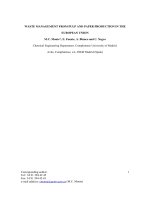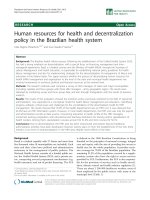Management for intermediat level anorectal malformation in male in the newborn period
Bạn đang xem bản rút gọn của tài liệu. Xem và tải ngay bản đầy đủ của tài liệu tại đây (6.91 MB, 28 trang )
Incidence
2.0–2.5 per 10,000 live births
Frequency
more frequently in boys than girls
Classification
Diagnosis
Radiography
Common causes for erroneous interpretation of prone,
cross-table lateral x-ray
Insufficient time for gas to reach the terminal bowel
Meconium plug in the terminal gut may produce an
erroneously high shadow
Active contraction of the levator ani/sphincter muscle
complex
Erroneous estimation of level may occur if the pelvic
floor muscles are relaxed, or if there is a sacral anomaly
gas in the vagina may be mistaken for gas in the distal
bowel
Management
Colostomy
Anorectal malformations with good prognosis: Variables affecting the functional
outcome
Rosella Arnodi et al.Volume 49, Issue 8, Pages 1232–1236
Backgroud/Purpose
The purpose of this study was to investigate the outcome of patients operated for anorectal
malformations (ARMs) with good prognosis.
Methods
Thirty patients underwent clinical evaluation by Rintala score and anorectal manometry
recording anal resting pressure (ARP), rectoanal inhibitory reflex (RAIR), and rectal
volume (RV). The results were analysed with regard to sex, type of ARM, surgical timing of
posterior sagittal anorectoplasty (PSARP), neurospinal cord dysraphism (ND), neonatal
colostomy, and institution where they underwent surgery.
Results
6/30 (20%) presented ND despite normal sacrum. 17/30 (57%) patients had a normal
Rintala score. ND and neonatal colostomy were significantly associated with a pathologic
score (p = 0.0029
and p = 0.0016).
Patients with ND had significantly lower ARP compared
to patients with normal spine (23.5 ± 7.2 mmHg vs 32 ± 7.9 mmHg, p = 0.023). ARP was
significantly lower in patients with neonatal colostomy compared to patients with primary
repair (25.22 ± 10.24 mmHg vs 32.57 ± 6.68 mmHg, p = 0.026). RAIR was present in only
2/6 (33%) patients with ND, while in 21/24 (87.5%) without ND (p = 0.015) and in 4/9
(44%) patients with neonatal colostomy, while in 19/21 (90.5%) patients submitted to
primary repair (p = 0.014).
Conclusions
Neurospinal cord dysraphism may be present despite normal sacral ratio. From a clinical
point of view, patients with good prognosis ARMs are not completely comparable to
healthy children. Neurospinal cord dysraphism and neonatal colostomy seem to worsen
the clinical and manometric (ARP and RAIR) outcomes of these patients.
Management
Peña A, Levitt MA. Imperforate Anus and Cloacal Malformations. Ashcraft
Pediatric Surgery, 4th ed. p 501
Operation









